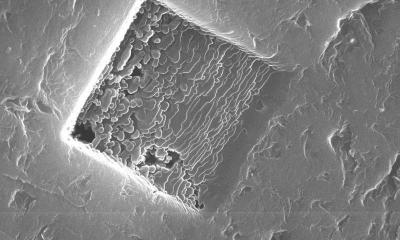Researchers at Rice University, along with colleagues in Texas, Brazil and India, have found that flakes of graphene oxide, welded together into a solid material, could be advantageous for bone implants. The team used used spark plasma sintering to weld flakes of graphene oxide into porous solids that compare favorably with the mechanical properties and biocompatibility of titanium, a standard bone-replacement material.
 A focused ion beam microscope image shows 3-D graphene layers welded together in a block
A focused ion beam microscope image shows 3-D graphene layers welded together in a block
The researchers stated that their technique will give them the ability to create highly complex shapes out of graphene in minutes using graphite molds, which they believe would be easier to process than specialty metals. They also said that spark plasma sintering is being used in industry to make complex parts, generally with ceramics. "The technique uses a high pulse current that welds the flakes together instantly. You only need high voltage, not high pressure or temperatures". The material they made is nearly 50% porous, with a density half that of graphite and a quarter of titanium metal. But it has enough compressive strengthâ40 megapascalsâto qualify it for bone implants. The strength of the bonds between sheets keeps it from disintegrating in water.
The researchers controlled the density of the material by altering the voltage that delivers the highly localized blast of heat that makes the nanoscale welds. Though the experiments were carried out at room temperature, the researchers made graphene solids of various density by raising these sintering temperatures from 200 to 400 degrees Celsius. Samples made at local temperatures of 300 C proved best, the team said.
The researchers measured the load-bearing capacity of thin sheets of two- to five-layer bonded graphene by repeatedly stressing them with a picoindenter attached to a scanning electron microscope and found they were stable up to 70 micronewtons. Colleagues at the University of Texas MD Anderson Cancer Center successfully cultured cells on the material to show its biocompatibility. As a bonus, the researchers also discovered the sintering process has the ability to reduce graphene oxide flakes to pure bilayer graphene, which makes them stronger and more stable than graphene monolayers or graphene oxide.